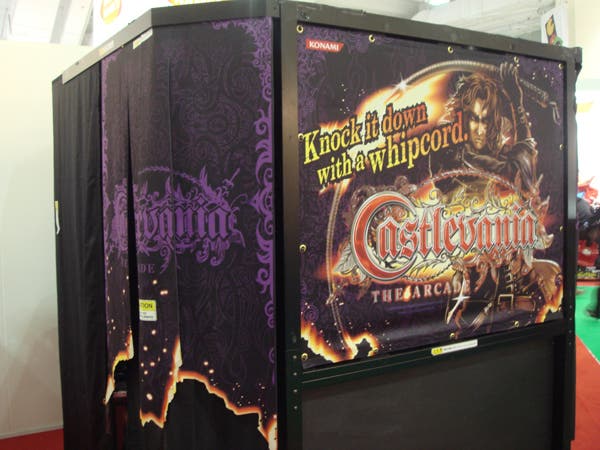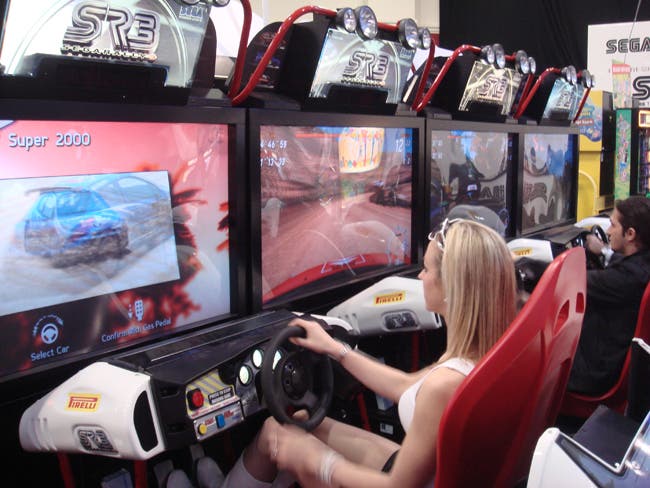ATEI 2009 Show Report
Hands and coins-on at the annual arcade trade show.
At one point it was unthinkable that Street Fighter II would disappear from every greasy spoon on the map - but it happened. On today's arcade cardiograph, there is a slow pulse, a protracted blip in the darkness that represents the last bastion of hope for an ailing UK industry. But enough of the woe stories. Having understood and agreed that the rise of the console has spelled slow death for the most social of videogaming activities, it's time to take a glass-half-full approach to ATEI 2009.
Suited businessmen descend on Earls Court every year as if it were a charmed place, a temple for their industry where they can talk shop and chug beer with colleagues and trading partners. All this while ignoring the two ginger kids head-butting the punch-bag machine. Yes, the UK's largest refuge for children bunking school is back in what could be considered full force.
For what it's worth, the show has conjured a renewed energy from somewhere. The stands dedicated to actual videogaming are now spread out across the upper floor rather than boxed in a single location. It's only a small detail, but one that successfully dilutes the colourful parade of redemption machines and tat vendors.

The presence of the Japanese contingent is great in size but not in number. Even though the Namco Bandai stand is in a prime spot, there's not a great deal on show bar its impressive new gun game, Razing Storm. Set in a beige future, you assist a stereotypical combat unit as they run around derelict buildings pumping stuff full of lead. As Gears of War demonstrated, stereotypes are good, especially those which promote machismo and violence. It's pretty sexy, with scenery decimation that's reminiscent of Crisis Zone and a grittier style than the rather plastic Time Crisis 4.
The Konami stand next door is looking a little unloved. Guitar Hero Arcade is centre-stage, featuring over forty songs and eleven characters. It's far too similar to the home versions to really enthuse, but a safe bet for industry pundits. Much more exciting is U-beat, a rhythm-action title that's currently taking Asia by storm. With possibilities of linking up to four machines, the game is played on a four-by-four grid of sixteen squares that light up in time with the music. This may not seem like much of an evolution from Beatmania, but attempting to control the grid's pulsing sequences of sound and colour is intensely engrossing.
The new GTI Club is a decent racing distraction in its French Riviera-themed booth, and at the back of the stand Byon Byon!, a mini-game romp with shades of Ren and Stimpy-esque madness, is good fun, even if the overblown controllers are a little unwieldy. The one we're most excited about is, incidentally, the one that's getting the least attention: Castlevania The Arcade Game.

Inside the mini-theatre setup we take up a whip controller, which is fashioned and implemented almost identically to Konami's own sword-swinging Blade of Honor. All hope is shattered by the calibration though, which is a total mess. With the whip not responding properly, it degenerates into an arm-wearying affair where only wild flurries of movement seem to have any effect. Although gimmicky, were it working properly it could be an attractive novelty, featuring music, secondary weapons and characters from Castlevania lore. It's just a shame that this initial demonstration is in such a poor state.
Nearby, Australian arcade distributor Highway Games has brought Street Fighter IV and Tekken 6 to the show. Despite hogging the area as much as they did the Namco stand the year prior, Highway seems to appreciate the attention of fighting game die-hards. Next door, Japanese vendor River Service is demonstrating Arc System's BlazBlue and Taito's painfully poor sequel, Chase H.Q. 2.
Surprisingly, the biggest crowd-pleaser happens to be a redemption machine, the hook being that rather than controlling a grab claw you get to control a robot. Yes, a robot. On a cool factor it's right up there. The objective is to have him walk up to a fluffy doll, grab it and bring it over to the prize chute within a sixty-second timeframe. Apocalyptic visions abound of a future Japanese war in which they'll likely roll one out that's large enough to destroy small cities, or a more likely future in which Eurogamer's editor sends one out to retrieve overdue copy. Eek!

The SEGA stand on the opposite side of the hall is by far the most adventurous of the show. Big, bright and buzzing with booth girls in hotpants. It's a more than worthy turn from the big S, but a shame that there are so few exclusives. Rambo cabinets sit four in a row, as do the Hummer, Harley Davidson and Ghost Squad machines. Although the Typhoon 4D simulator ride is a good indication of the demand for non-competitive, family-orientated arcades, it doesn't provide anywhere near the same thrills as SEGA Rally 3 which, despite striking similarities to the recent console release, is one of the show highlights. The visuals are beautifully smooth and the handling of the cars as they burn around gravelly mountain roads feels just right. It arrives across Europe later this year.
As the afternoon turns to evening and the hand strikes six, in true Cinderella fashion the magic disappears instantly as the machines across the floor shut down. The blur of colour and sound that's hung on the air all day is suddenly gone, and we stroll between a graveyard of blank screens as we head for the exit. In the lobby a youth is waving his belt around and shouting obscenities as a security guard shuffles him to the exit.
As the doors close on ATEI for another year, it's easy to be cynical. It's easy to dwell on a golden era when busy arcades smelled like cigarettes and cleaning fluid and the chimes of Capcom logos and Space Harrier demos would ring out all day long. The question is, do we spend our time reminiscing about the scene of the past or do our best to look to the future? In the end it all amounts to one simple truth, and that's that the future is all we've got.

